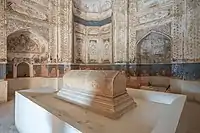Tomb of Mian Ghulam Kalhoro
The Tomb of Mian Ghulam Kalhoro is a religious shrine situated in Hyderabad, Sindh, Pakistan. It is the burial place of Mian Ghulam Shah Kalhoro[1] who died in 1772 and is believed to be the founder of the city of Hyderabad in Pakistan as well as the second most important figure in Sindh after Shah Abdul Latif Bhittai. It is the oldest building in Hyderabad.[2]
| Mian Ghulam Shah Kalhoro Shrine | |
|---|---|
 | |
| Religion | |
| Affiliation | Islam |
| Province | Sindh |
| Ecclesiastical or organizational status | Tomb |
| Year consecrated | 1772 |
| Location | |
| Location | Hyderabad, Sindh |
| Architecture | |
| Type | Mausoleum |
| Style | Islamic |
| Dome(s) | 1 |
Description
The Mausoleum of Kalhoro is 56 feet (17 m) in width and 36 feet (11 m) in height. The shrine is built inside a rectangular shaped fort. The interior of the tomb is a wonderful example of Sindhi art which is decorated with gildings, arc shaped windows and tiles. The arc-shaped windows are filled with terracotta grilles of geometrical patterns.[3]
Upkeep
The walled enclosure of the tomb area has gradually been filled by graves of other people, turning it into a graveyard.[4] Since 2011, its preservation has been placed in charge of the government of the province of Sindh.[3]
The domed roof of the tomb fell in the early 20th century, and was replaced by a flat roof.[2] It has since been restored.
Gallery
 Side view
Side view Interior of the mausoleum
Interior of the mausoleum Dome interior
Dome interior
| Wikimedia Commons has media related to Mian Ghulam Shah Kalhoro shrine. |
References
- "Tomb Of Mian Ghulam Nabi Kalhoro, Hyderabad". Directorate General of Antiquities. Government of Sindh. Retrieved 2020-10-17.
- Hazan, Shazia (21 March 2016). "Kalhoro mausoleum: Where no one comes to offer fateha". Dawn.
- Wagan, Ahmed Faraz; Khan, Bhai; Brohi, Muhammad Afzal (December 2019). "Comparing kashi tiles of Mir's and Kalharo tombs – case study of Hyderabad" (PDF). Engineering Science and Technology International Research Journal. 3 (4): 42–50.
- "239th death anniversary: What would the man who built Hyderabad think of it today?". The Express Tribune. August 8, 2011. Archived from the original on July 2, 2014. Retrieved July 2, 2014.
External links
- Tomb of Mian Ghulam Shah Kalhoro, pre-restoration, by Government of Sindh
- Ghulam Shah Kalhora, Hyderabad, Sindh, pre-restoration, by Marvi Mazhar, 2015